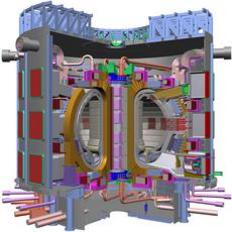 ITER is a joint international research and development project that aims to demonstrate the scientific and technical feasibility of fusion power. The partners in the project – the ITER Parties – are the European Union (represented by EURATOM), Japan, the People’s Republic of China, India, the Republic of Korea, the Russian Federation and the USA. ITER will be constructed in Europe, at Cadarache in the South of France.The ITER device is based on the tokamak concept and will produce 500 MW of fusion power.Through its proposal in 2003 of an ITER ICRH launcher with an external matching system, LPP-ERM/KMS signalled a strong commitment to ITER. In April 2007, the ITER Working Group on Heating and Current Drive (WGHCD) recommended that the reference design for ICRH on ITER should be based on the LPP-ERM/KMS proposal. Our ITER effort over the last years aimed, in close collaboration with UKAEA, ORNL (US) and ITER IT, at further verifying ITER’s functional requirements and at implementing additional recommendations of the WGHCD.
ITER is a joint international research and development project that aims to demonstrate the scientific and technical feasibility of fusion power. The partners in the project – the ITER Parties – are the European Union (represented by EURATOM), Japan, the People’s Republic of China, India, the Republic of Korea, the Russian Federation and the USA. ITER will be constructed in Europe, at Cadarache in the South of France.The ITER device is based on the tokamak concept and will produce 500 MW of fusion power.Through its proposal in 2003 of an ITER ICRH launcher with an external matching system, LPP-ERM/KMS signalled a strong commitment to ITER. In April 2007, the ITER Working Group on Heating and Current Drive (WGHCD) recommended that the reference design for ICRH on ITER should be based on the LPP-ERM/KMS proposal. Our ITER effort over the last years aimed, in close collaboration with UKAEA, ORNL (US) and ITER IT, at further verifying ITER’s functional requirements and at implementing additional recommendations of the WGHCD.
 The ITER ICRF antenna consists of a close-packed array of 24 straps arranged in a 6 poloidal by 4 toroidal array. Three poloidally adjacent straps (a “triplet” of straps) are fed in parallel through a 4-port junction from one single 20Ω feeding line. Load tolerance is achieved by feeding two poloidal triplets through either a 3dB hybrid coupler or a conjugate-T scheme. The array has to radiate 20MW of RF power over a frequency range of 40MHz to 55MHz and for different toroidal phasing. The figure on the left shows a cut of the front part of the antenna. It consists of 2 poloidally adjacent triplets, with the Faraday screen visible in front of the array. The straps (strip lines facing the plasma) are fed by the 4-port junction, and are connected through the matching circuit (not shown) to the generators. In order to reduce mutual coupling, the two triplets are separated by a vertical septum, which is part of the antenna housing. The whole antenna is recessed from the first wall of the tokamak. The high power density of the compact antenna, the large antenna-plasma distance and the mutual coupling between the 24 straps make the design of the ITER antenna system a challenging task.
The ITER ICRF antenna consists of a close-packed array of 24 straps arranged in a 6 poloidal by 4 toroidal array. Three poloidally adjacent straps (a “triplet” of straps) are fed in parallel through a 4-port junction from one single 20Ω feeding line. Load tolerance is achieved by feeding two poloidal triplets through either a 3dB hybrid coupler or a conjugate-T scheme. The array has to radiate 20MW of RF power over a frequency range of 40MHz to 55MHz and for different toroidal phasing. The figure on the left shows a cut of the front part of the antenna. It consists of 2 poloidally adjacent triplets, with the Faraday screen visible in front of the array. The straps (strip lines facing the plasma) are fed by the 4-port junction, and are connected through the matching circuit (not shown) to the generators. In order to reduce mutual coupling, the two triplets are separated by a vertical septum, which is part of the antenna housing. The whole antenna is recessed from the first wall of the tokamak. The high power density of the compact antenna, the large antenna-plasma distance and the mutual coupling between the 24 straps make the design of the ITER antenna system a challenging task.